PMN610: Project Management Analysis of Health Payroll System
VerifiedAdded on 2023/06/08
|10
|2508
|107
Case Study
AI Summary
This case study provides a comprehensive analysis of the Queensland Health Payroll System project failure, examining the underlying issues related to scope management, cost management, and communication management. The report identifies key reasons for the project's shortcomings, including inadequate scope estimation, poor cost control, and ineffective communication strategies. Furthermore, it offers practical recommendations for preventing similar failures in future projects, emphasizing the importance of accurate scope definition, robust project governance, clear business requirement definitions, and diligent project monitoring. The analysis draws upon project management principles and practices to provide valuable insights into the complexities of managing large-scale IT projects and highlights the critical role of effective project management in achieving successful outcomes. This document is available on Desklib, where students can access a wealth of study resources including past papers and solved assignments.
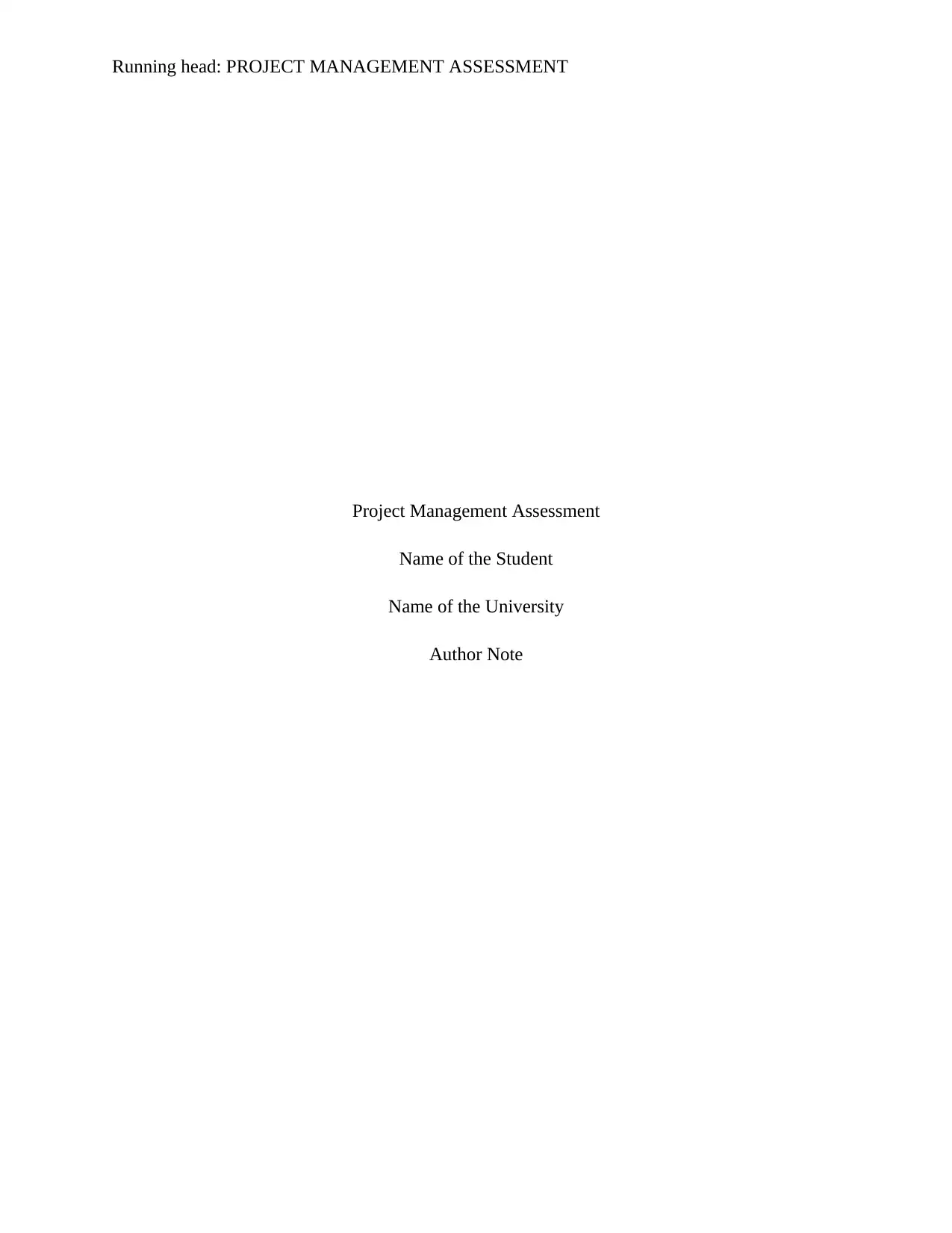
Running head: PROJECT MANAGEMENT ASSESSMENT
Project Management Assessment
Name of the Student
Name of the University
Author Note
Project Management Assessment
Name of the Student
Name of the University
Author Note
Paraphrase This Document
Need a fresh take? Get an instant paraphrase of this document with our AI Paraphraser
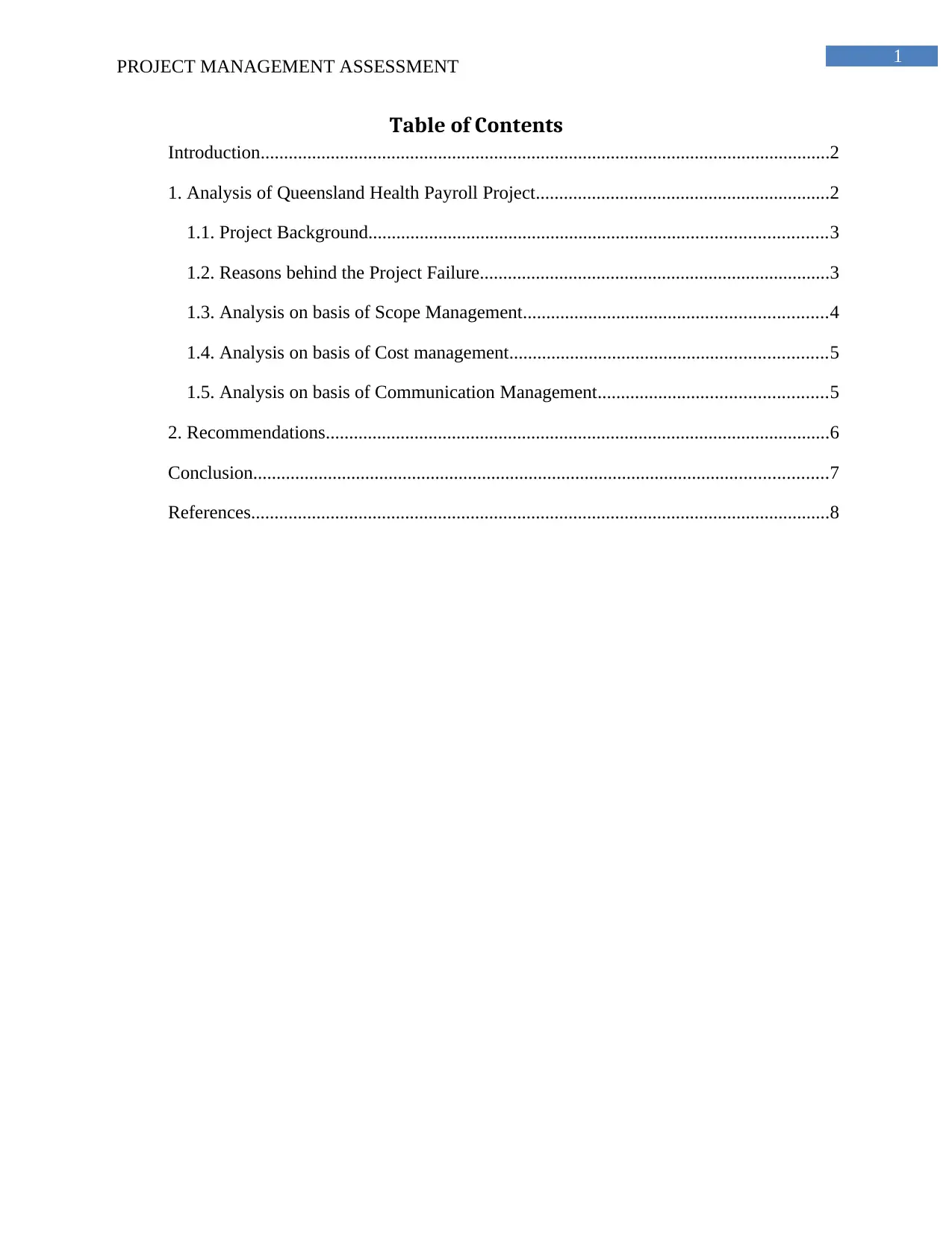
1
PROJECT MANAGEMENT ASSESSMENT
Table of Contents
Introduction..........................................................................................................................2
1. Analysis of Queensland Health Payroll Project...............................................................2
1.1. Project Background..................................................................................................3
1.2. Reasons behind the Project Failure...........................................................................3
1.3. Analysis on basis of Scope Management.................................................................4
1.4. Analysis on basis of Cost management....................................................................5
1.5. Analysis on basis of Communication Management.................................................5
2. Recommendations............................................................................................................6
Conclusion...........................................................................................................................7
References............................................................................................................................8
PROJECT MANAGEMENT ASSESSMENT
Table of Contents
Introduction..........................................................................................................................2
1. Analysis of Queensland Health Payroll Project...............................................................2
1.1. Project Background..................................................................................................3
1.2. Reasons behind the Project Failure...........................................................................3
1.3. Analysis on basis of Scope Management.................................................................4
1.4. Analysis on basis of Cost management....................................................................5
1.5. Analysis on basis of Communication Management.................................................5
2. Recommendations............................................................................................................6
Conclusion...........................................................................................................................7
References............................................................................................................................8
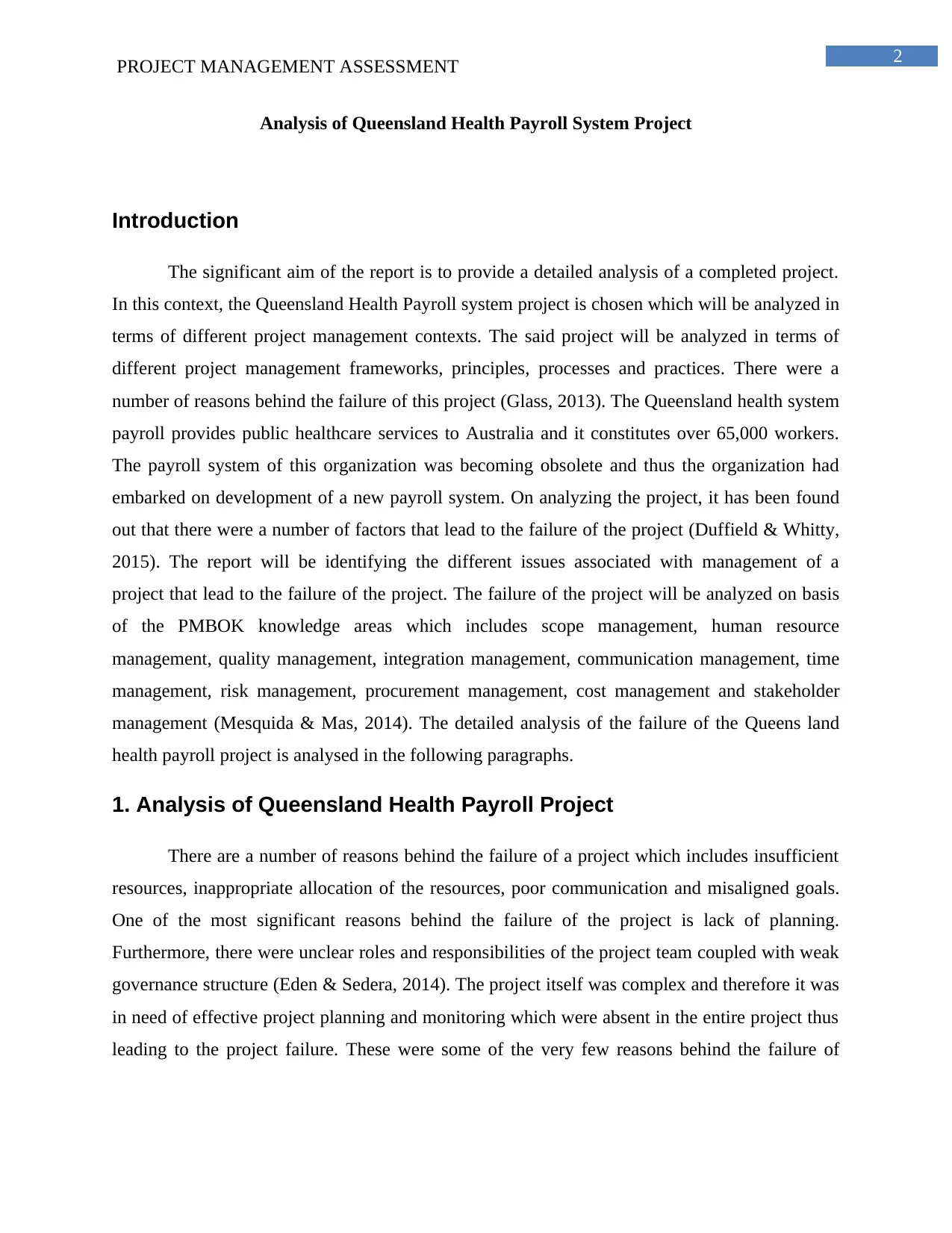
2
PROJECT MANAGEMENT ASSESSMENT
Analysis of Queensland Health Payroll System Project
Introduction
The significant aim of the report is to provide a detailed analysis of a completed project.
In this context, the Queensland Health Payroll system project is chosen which will be analyzed in
terms of different project management contexts. The said project will be analyzed in terms of
different project management frameworks, principles, processes and practices. There were a
number of reasons behind the failure of this project (Glass, 2013). The Queensland health system
payroll provides public healthcare services to Australia and it constitutes over 65,000 workers.
The payroll system of this organization was becoming obsolete and thus the organization had
embarked on development of a new payroll system. On analyzing the project, it has been found
out that there were a number of factors that lead to the failure of the project (Duffield & Whitty,
2015). The report will be identifying the different issues associated with management of a
project that lead to the failure of the project. The failure of the project will be analyzed on basis
of the PMBOK knowledge areas which includes scope management, human resource
management, quality management, integration management, communication management, time
management, risk management, procurement management, cost management and stakeholder
management (Mesquida & Mas, 2014). The detailed analysis of the failure of the Queens land
health payroll project is analysed in the following paragraphs.
1. Analysis of Queensland Health Payroll Project
There are a number of reasons behind the failure of a project which includes insufficient
resources, inappropriate allocation of the resources, poor communication and misaligned goals.
One of the most significant reasons behind the failure of the project is lack of planning.
Furthermore, there were unclear roles and responsibilities of the project team coupled with weak
governance structure (Eden & Sedera, 2014). The project itself was complex and therefore it was
in need of effective project planning and monitoring which were absent in the entire project thus
leading to the project failure. These were some of the very few reasons behind the failure of
PROJECT MANAGEMENT ASSESSMENT
Analysis of Queensland Health Payroll System Project
Introduction
The significant aim of the report is to provide a detailed analysis of a completed project.
In this context, the Queensland Health Payroll system project is chosen which will be analyzed in
terms of different project management contexts. The said project will be analyzed in terms of
different project management frameworks, principles, processes and practices. There were a
number of reasons behind the failure of this project (Glass, 2013). The Queensland health system
payroll provides public healthcare services to Australia and it constitutes over 65,000 workers.
The payroll system of this organization was becoming obsolete and thus the organization had
embarked on development of a new payroll system. On analyzing the project, it has been found
out that there were a number of factors that lead to the failure of the project (Duffield & Whitty,
2015). The report will be identifying the different issues associated with management of a
project that lead to the failure of the project. The failure of the project will be analyzed on basis
of the PMBOK knowledge areas which includes scope management, human resource
management, quality management, integration management, communication management, time
management, risk management, procurement management, cost management and stakeholder
management (Mesquida & Mas, 2014). The detailed analysis of the failure of the Queens land
health payroll project is analysed in the following paragraphs.
1. Analysis of Queensland Health Payroll Project
There are a number of reasons behind the failure of a project which includes insufficient
resources, inappropriate allocation of the resources, poor communication and misaligned goals.
One of the most significant reasons behind the failure of the project is lack of planning.
Furthermore, there were unclear roles and responsibilities of the project team coupled with weak
governance structure (Eden & Sedera, 2014). The project itself was complex and therefore it was
in need of effective project planning and monitoring which were absent in the entire project thus
leading to the project failure. These were some of the very few reasons behind the failure of
⊘ This is a preview!⊘
Do you want full access?
Subscribe today to unlock all pages.

Trusted by 1+ million students worldwide
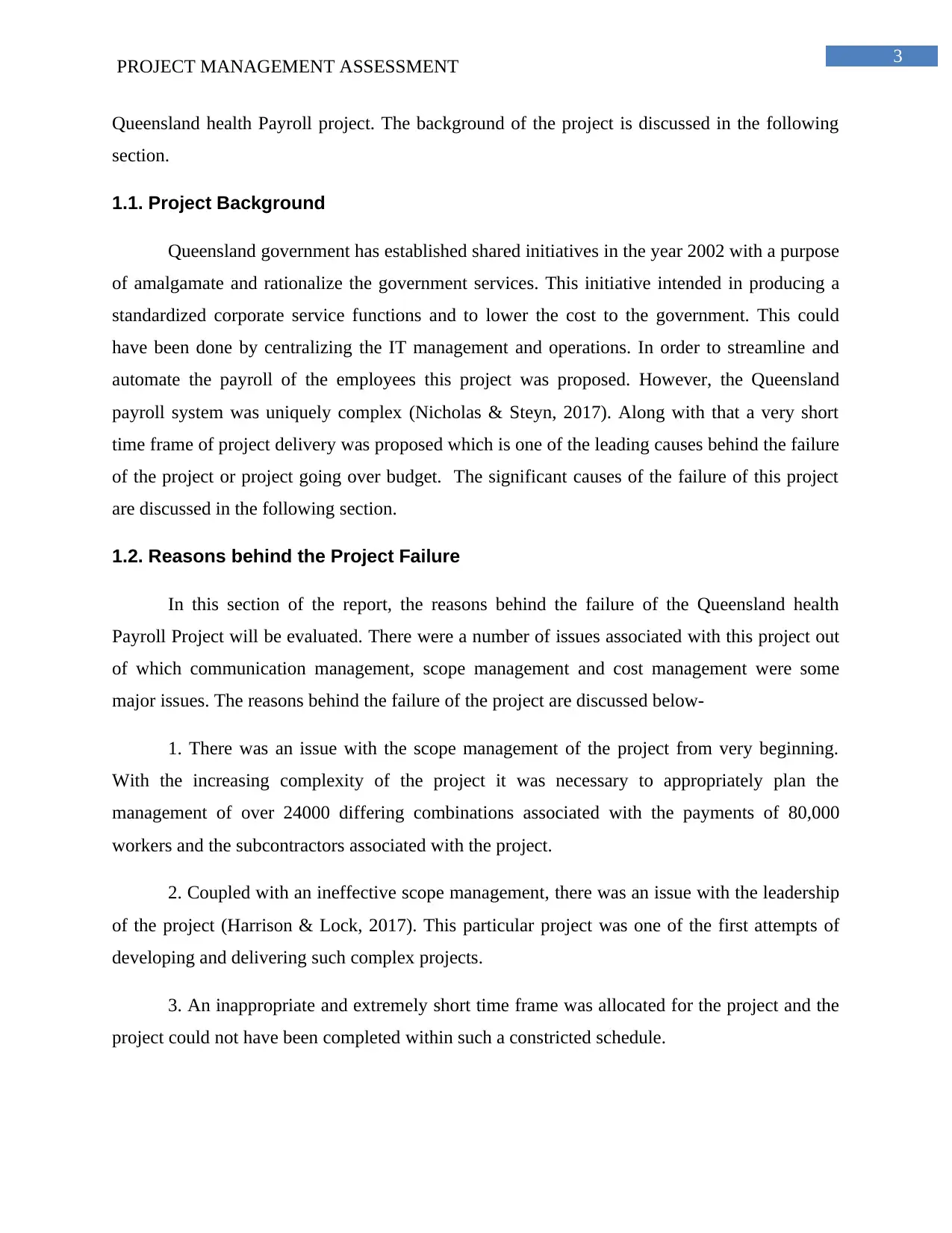
3
PROJECT MANAGEMENT ASSESSMENT
Queensland health Payroll project. The background of the project is discussed in the following
section.
1.1. Project Background
Queensland government has established shared initiatives in the year 2002 with a purpose
of amalgamate and rationalize the government services. This initiative intended in producing a
standardized corporate service functions and to lower the cost to the government. This could
have been done by centralizing the IT management and operations. In order to streamline and
automate the payroll of the employees this project was proposed. However, the Queensland
payroll system was uniquely complex (Nicholas & Steyn, 2017). Along with that a very short
time frame of project delivery was proposed which is one of the leading causes behind the failure
of the project or project going over budget. The significant causes of the failure of this project
are discussed in the following section.
1.2. Reasons behind the Project Failure
In this section of the report, the reasons behind the failure of the Queensland health
Payroll Project will be evaluated. There were a number of issues associated with this project out
of which communication management, scope management and cost management were some
major issues. The reasons behind the failure of the project are discussed below-
1. There was an issue with the scope management of the project from very beginning.
With the increasing complexity of the project it was necessary to appropriately plan the
management of over 24000 differing combinations associated with the payments of 80,000
workers and the subcontractors associated with the project.
2. Coupled with an ineffective scope management, there was an issue with the leadership
of the project (Harrison & Lock, 2017). This particular project was one of the first attempts of
developing and delivering such complex projects.
3. An inappropriate and extremely short time frame was allocated for the project and the
project could not have been completed within such a constricted schedule.
PROJECT MANAGEMENT ASSESSMENT
Queensland health Payroll project. The background of the project is discussed in the following
section.
1.1. Project Background
Queensland government has established shared initiatives in the year 2002 with a purpose
of amalgamate and rationalize the government services. This initiative intended in producing a
standardized corporate service functions and to lower the cost to the government. This could
have been done by centralizing the IT management and operations. In order to streamline and
automate the payroll of the employees this project was proposed. However, the Queensland
payroll system was uniquely complex (Nicholas & Steyn, 2017). Along with that a very short
time frame of project delivery was proposed which is one of the leading causes behind the failure
of the project or project going over budget. The significant causes of the failure of this project
are discussed in the following section.
1.2. Reasons behind the Project Failure
In this section of the report, the reasons behind the failure of the Queensland health
Payroll Project will be evaluated. There were a number of issues associated with this project out
of which communication management, scope management and cost management were some
major issues. The reasons behind the failure of the project are discussed below-
1. There was an issue with the scope management of the project from very beginning.
With the increasing complexity of the project it was necessary to appropriately plan the
management of over 24000 differing combinations associated with the payments of 80,000
workers and the subcontractors associated with the project.
2. Coupled with an ineffective scope management, there was an issue with the leadership
of the project (Harrison & Lock, 2017). This particular project was one of the first attempts of
developing and delivering such complex projects.
3. An inappropriate and extremely short time frame was allocated for the project and the
project could not have been completed within such a constricted schedule.
Paraphrase This Document
Need a fresh take? Get an instant paraphrase of this document with our AI Paraphraser
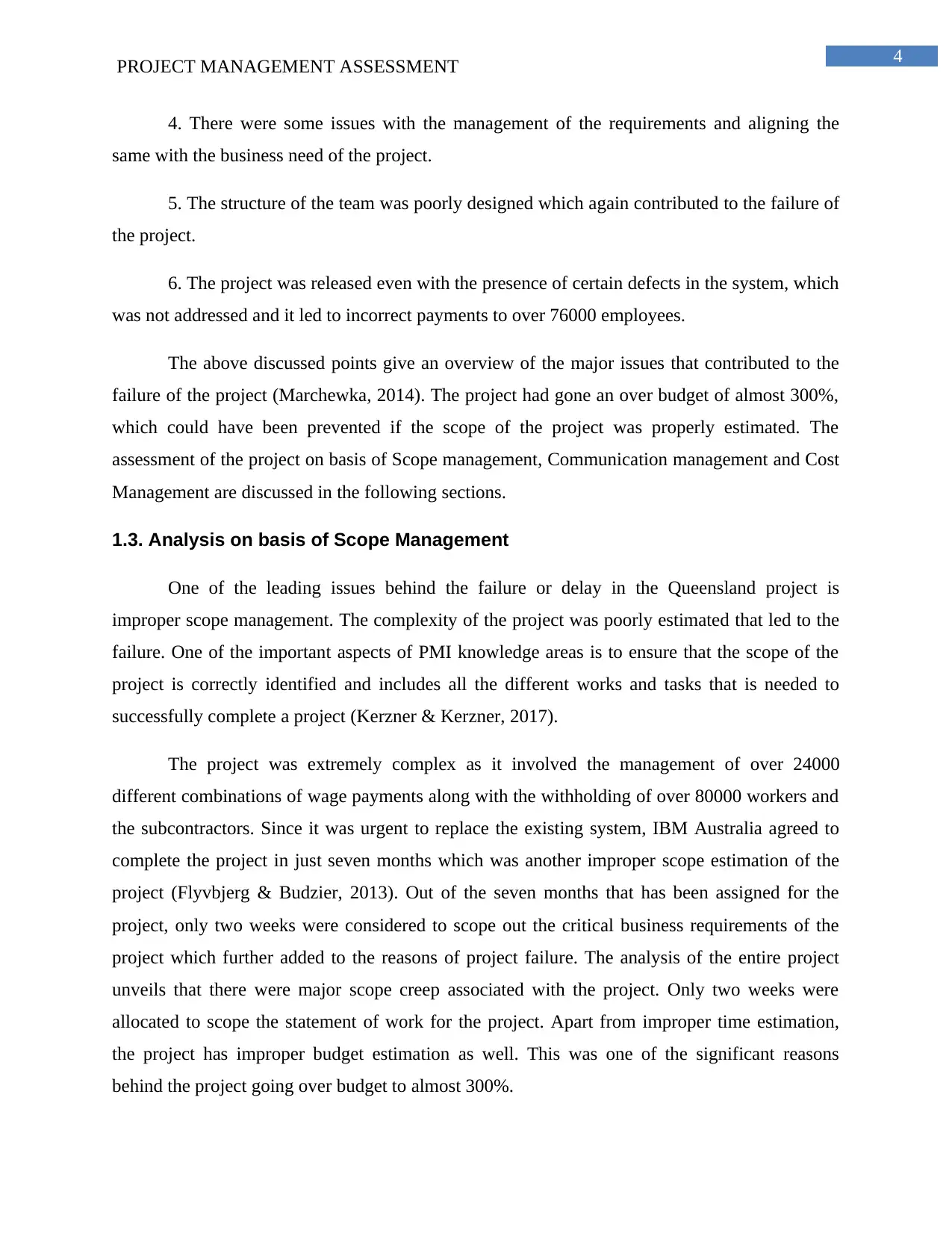
4
PROJECT MANAGEMENT ASSESSMENT
4. There were some issues with the management of the requirements and aligning the
same with the business need of the project.
5. The structure of the team was poorly designed which again contributed to the failure of
the project.
6. The project was released even with the presence of certain defects in the system, which
was not addressed and it led to incorrect payments to over 76000 employees.
The above discussed points give an overview of the major issues that contributed to the
failure of the project (Marchewka, 2014). The project had gone an over budget of almost 300%,
which could have been prevented if the scope of the project was properly estimated. The
assessment of the project on basis of Scope management, Communication management and Cost
Management are discussed in the following sections.
1.3. Analysis on basis of Scope Management
One of the leading issues behind the failure or delay in the Queensland project is
improper scope management. The complexity of the project was poorly estimated that led to the
failure. One of the important aspects of PMI knowledge areas is to ensure that the scope of the
project is correctly identified and includes all the different works and tasks that is needed to
successfully complete a project (Kerzner & Kerzner, 2017).
The project was extremely complex as it involved the management of over 24000
different combinations of wage payments along with the withholding of over 80000 workers and
the subcontractors. Since it was urgent to replace the existing system, IBM Australia agreed to
complete the project in just seven months which was another improper scope estimation of the
project (Flyvbjerg & Budzier, 2013). Out of the seven months that has been assigned for the
project, only two weeks were considered to scope out the critical business requirements of the
project which further added to the reasons of project failure. The analysis of the entire project
unveils that there were major scope creep associated with the project. Only two weeks were
allocated to scope the statement of work for the project. Apart from improper time estimation,
the project has improper budget estimation as well. This was one of the significant reasons
behind the project going over budget to almost 300%.
PROJECT MANAGEMENT ASSESSMENT
4. There were some issues with the management of the requirements and aligning the
same with the business need of the project.
5. The structure of the team was poorly designed which again contributed to the failure of
the project.
6. The project was released even with the presence of certain defects in the system, which
was not addressed and it led to incorrect payments to over 76000 employees.
The above discussed points give an overview of the major issues that contributed to the
failure of the project (Marchewka, 2014). The project had gone an over budget of almost 300%,
which could have been prevented if the scope of the project was properly estimated. The
assessment of the project on basis of Scope management, Communication management and Cost
Management are discussed in the following sections.
1.3. Analysis on basis of Scope Management
One of the leading issues behind the failure or delay in the Queensland project is
improper scope management. The complexity of the project was poorly estimated that led to the
failure. One of the important aspects of PMI knowledge areas is to ensure that the scope of the
project is correctly identified and includes all the different works and tasks that is needed to
successfully complete a project (Kerzner & Kerzner, 2017).
The project was extremely complex as it involved the management of over 24000
different combinations of wage payments along with the withholding of over 80000 workers and
the subcontractors. Since it was urgent to replace the existing system, IBM Australia agreed to
complete the project in just seven months which was another improper scope estimation of the
project (Flyvbjerg & Budzier, 2013). Out of the seven months that has been assigned for the
project, only two weeks were considered to scope out the critical business requirements of the
project which further added to the reasons of project failure. The analysis of the entire project
unveils that there were major scope creep associated with the project. Only two weeks were
allocated to scope the statement of work for the project. Apart from improper time estimation,
the project has improper budget estimation as well. This was one of the significant reasons
behind the project going over budget to almost 300%.
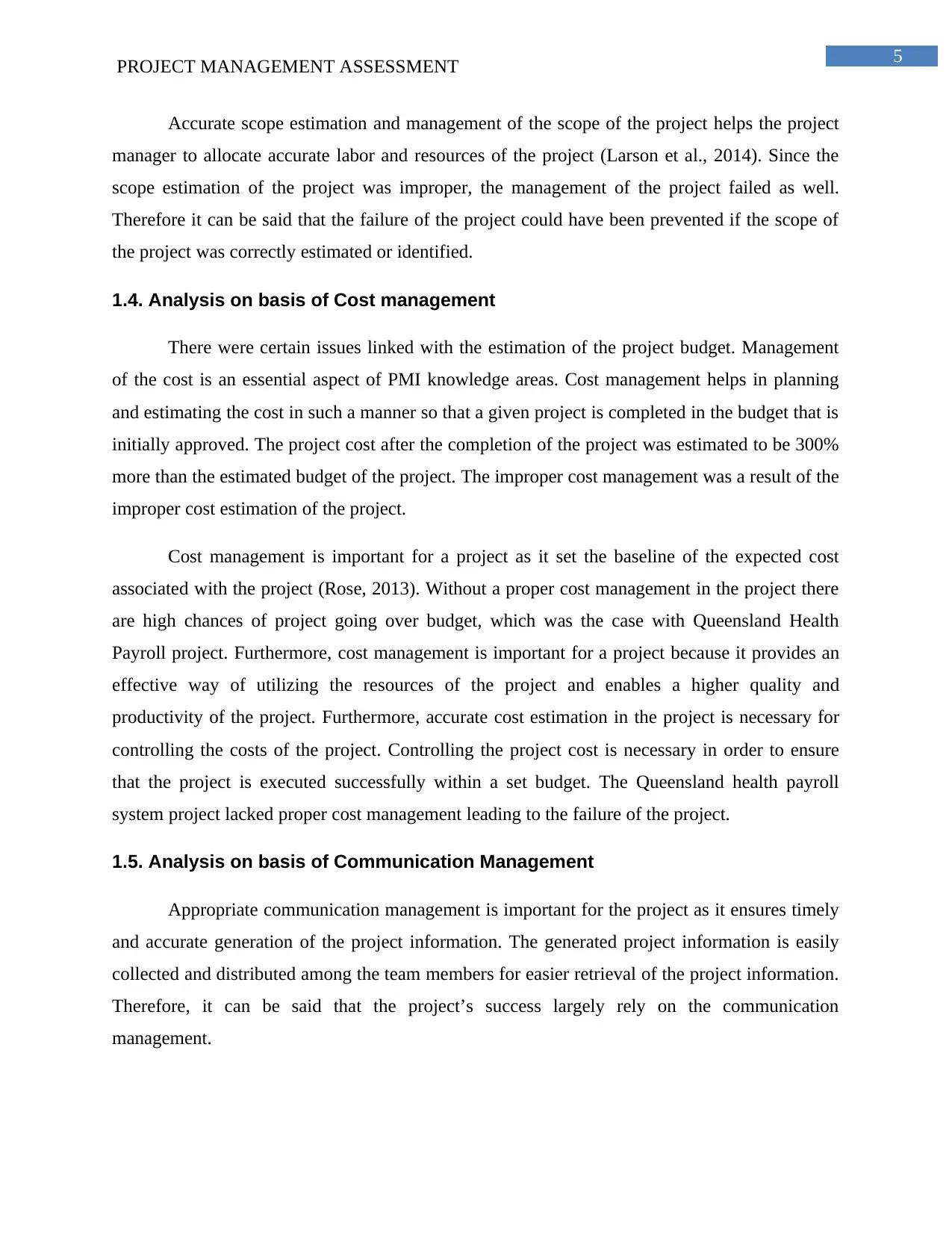
5
PROJECT MANAGEMENT ASSESSMENT
Accurate scope estimation and management of the scope of the project helps the project
manager to allocate accurate labor and resources of the project (Larson et al., 2014). Since the
scope estimation of the project was improper, the management of the project failed as well.
Therefore it can be said that the failure of the project could have been prevented if the scope of
the project was correctly estimated or identified.
1.4. Analysis on basis of Cost management
There were certain issues linked with the estimation of the project budget. Management
of the cost is an essential aspect of PMI knowledge areas. Cost management helps in planning
and estimating the cost in such a manner so that a given project is completed in the budget that is
initially approved. The project cost after the completion of the project was estimated to be 300%
more than the estimated budget of the project. The improper cost management was a result of the
improper cost estimation of the project.
Cost management is important for a project as it set the baseline of the expected cost
associated with the project (Rose, 2013). Without a proper cost management in the project there
are high chances of project going over budget, which was the case with Queensland Health
Payroll project. Furthermore, cost management is important for a project because it provides an
effective way of utilizing the resources of the project and enables a higher quality and
productivity of the project. Furthermore, accurate cost estimation in the project is necessary for
controlling the costs of the project. Controlling the project cost is necessary in order to ensure
that the project is executed successfully within a set budget. The Queensland health payroll
system project lacked proper cost management leading to the failure of the project.
1.5. Analysis on basis of Communication Management
Appropriate communication management is important for the project as it ensures timely
and accurate generation of the project information. The generated project information is easily
collected and distributed among the team members for easier retrieval of the project information.
Therefore, it can be said that the project’s success largely rely on the communication
management.
PROJECT MANAGEMENT ASSESSMENT
Accurate scope estimation and management of the scope of the project helps the project
manager to allocate accurate labor and resources of the project (Larson et al., 2014). Since the
scope estimation of the project was improper, the management of the project failed as well.
Therefore it can be said that the failure of the project could have been prevented if the scope of
the project was correctly estimated or identified.
1.4. Analysis on basis of Cost management
There were certain issues linked with the estimation of the project budget. Management
of the cost is an essential aspect of PMI knowledge areas. Cost management helps in planning
and estimating the cost in such a manner so that a given project is completed in the budget that is
initially approved. The project cost after the completion of the project was estimated to be 300%
more than the estimated budget of the project. The improper cost management was a result of the
improper cost estimation of the project.
Cost management is important for a project as it set the baseline of the expected cost
associated with the project (Rose, 2013). Without a proper cost management in the project there
are high chances of project going over budget, which was the case with Queensland Health
Payroll project. Furthermore, cost management is important for a project because it provides an
effective way of utilizing the resources of the project and enables a higher quality and
productivity of the project. Furthermore, accurate cost estimation in the project is necessary for
controlling the costs of the project. Controlling the project cost is necessary in order to ensure
that the project is executed successfully within a set budget. The Queensland health payroll
system project lacked proper cost management leading to the failure of the project.
1.5. Analysis on basis of Communication Management
Appropriate communication management is important for the project as it ensures timely
and accurate generation of the project information. The generated project information is easily
collected and distributed among the team members for easier retrieval of the project information.
Therefore, it can be said that the project’s success largely rely on the communication
management.
⊘ This is a preview!⊘
Do you want full access?
Subscribe today to unlock all pages.

Trusted by 1+ million students worldwide
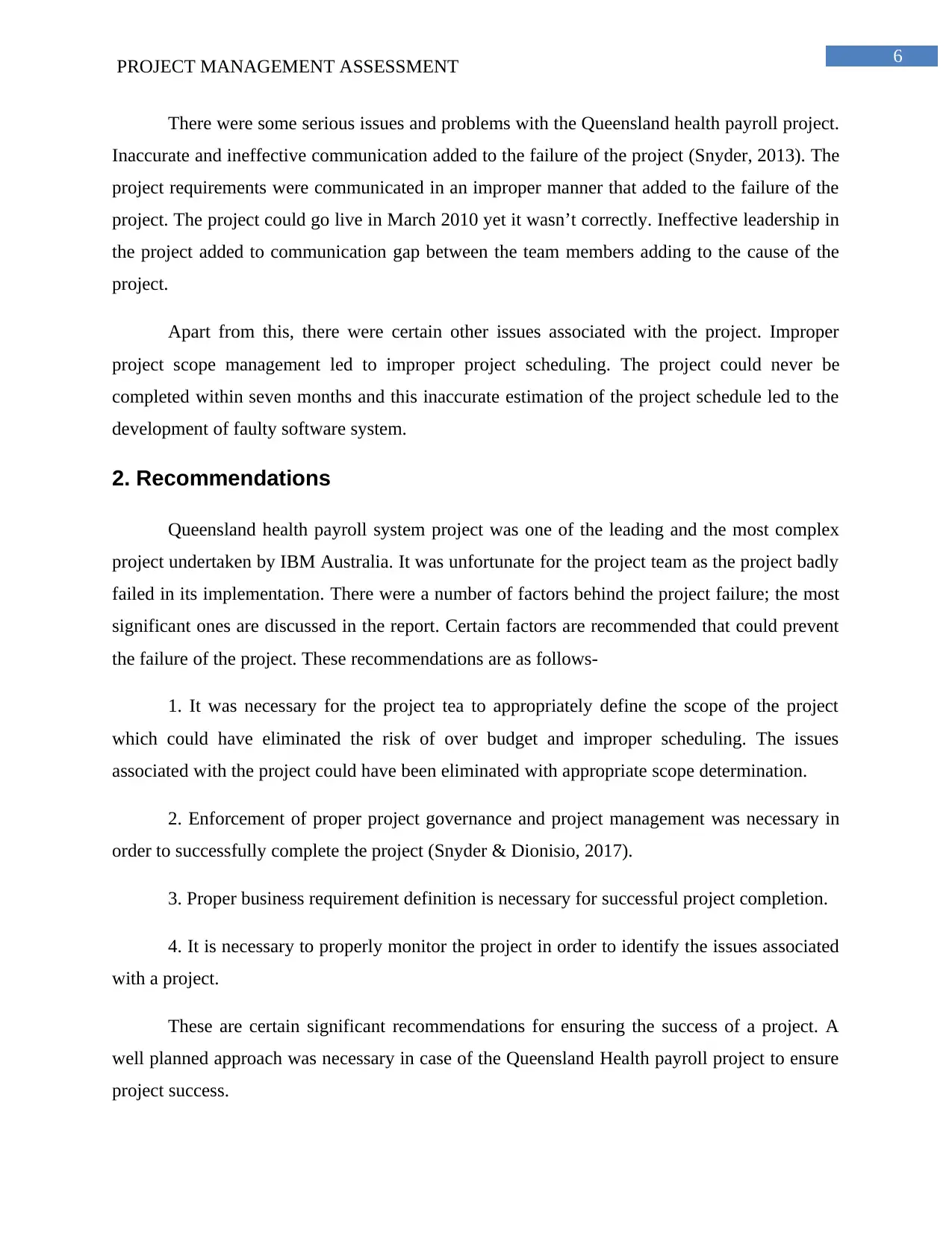
6
PROJECT MANAGEMENT ASSESSMENT
There were some serious issues and problems with the Queensland health payroll project.
Inaccurate and ineffective communication added to the failure of the project (Snyder, 2013). The
project requirements were communicated in an improper manner that added to the failure of the
project. The project could go live in March 2010 yet it wasn’t correctly. Ineffective leadership in
the project added to communication gap between the team members adding to the cause of the
project.
Apart from this, there were certain other issues associated with the project. Improper
project scope management led to improper project scheduling. The project could never be
completed within seven months and this inaccurate estimation of the project schedule led to the
development of faulty software system.
2. Recommendations
Queensland health payroll system project was one of the leading and the most complex
project undertaken by IBM Australia. It was unfortunate for the project team as the project badly
failed in its implementation. There were a number of factors behind the project failure; the most
significant ones are discussed in the report. Certain factors are recommended that could prevent
the failure of the project. These recommendations are as follows-
1. It was necessary for the project tea to appropriately define the scope of the project
which could have eliminated the risk of over budget and improper scheduling. The issues
associated with the project could have been eliminated with appropriate scope determination.
2. Enforcement of proper project governance and project management was necessary in
order to successfully complete the project (Snyder & Dionisio, 2017).
3. Proper business requirement definition is necessary for successful project completion.
4. It is necessary to properly monitor the project in order to identify the issues associated
with a project.
These are certain significant recommendations for ensuring the success of a project. A
well planned approach was necessary in case of the Queensland Health payroll project to ensure
project success.
PROJECT MANAGEMENT ASSESSMENT
There were some serious issues and problems with the Queensland health payroll project.
Inaccurate and ineffective communication added to the failure of the project (Snyder, 2013). The
project requirements were communicated in an improper manner that added to the failure of the
project. The project could go live in March 2010 yet it wasn’t correctly. Ineffective leadership in
the project added to communication gap between the team members adding to the cause of the
project.
Apart from this, there were certain other issues associated with the project. Improper
project scope management led to improper project scheduling. The project could never be
completed within seven months and this inaccurate estimation of the project schedule led to the
development of faulty software system.
2. Recommendations
Queensland health payroll system project was one of the leading and the most complex
project undertaken by IBM Australia. It was unfortunate for the project team as the project badly
failed in its implementation. There were a number of factors behind the project failure; the most
significant ones are discussed in the report. Certain factors are recommended that could prevent
the failure of the project. These recommendations are as follows-
1. It was necessary for the project tea to appropriately define the scope of the project
which could have eliminated the risk of over budget and improper scheduling. The issues
associated with the project could have been eliminated with appropriate scope determination.
2. Enforcement of proper project governance and project management was necessary in
order to successfully complete the project (Snyder & Dionisio, 2017).
3. Proper business requirement definition is necessary for successful project completion.
4. It is necessary to properly monitor the project in order to identify the issues associated
with a project.
These are certain significant recommendations for ensuring the success of a project. A
well planned approach was necessary in case of the Queensland Health payroll project to ensure
project success.
Paraphrase This Document
Need a fresh take? Get an instant paraphrase of this document with our AI Paraphraser
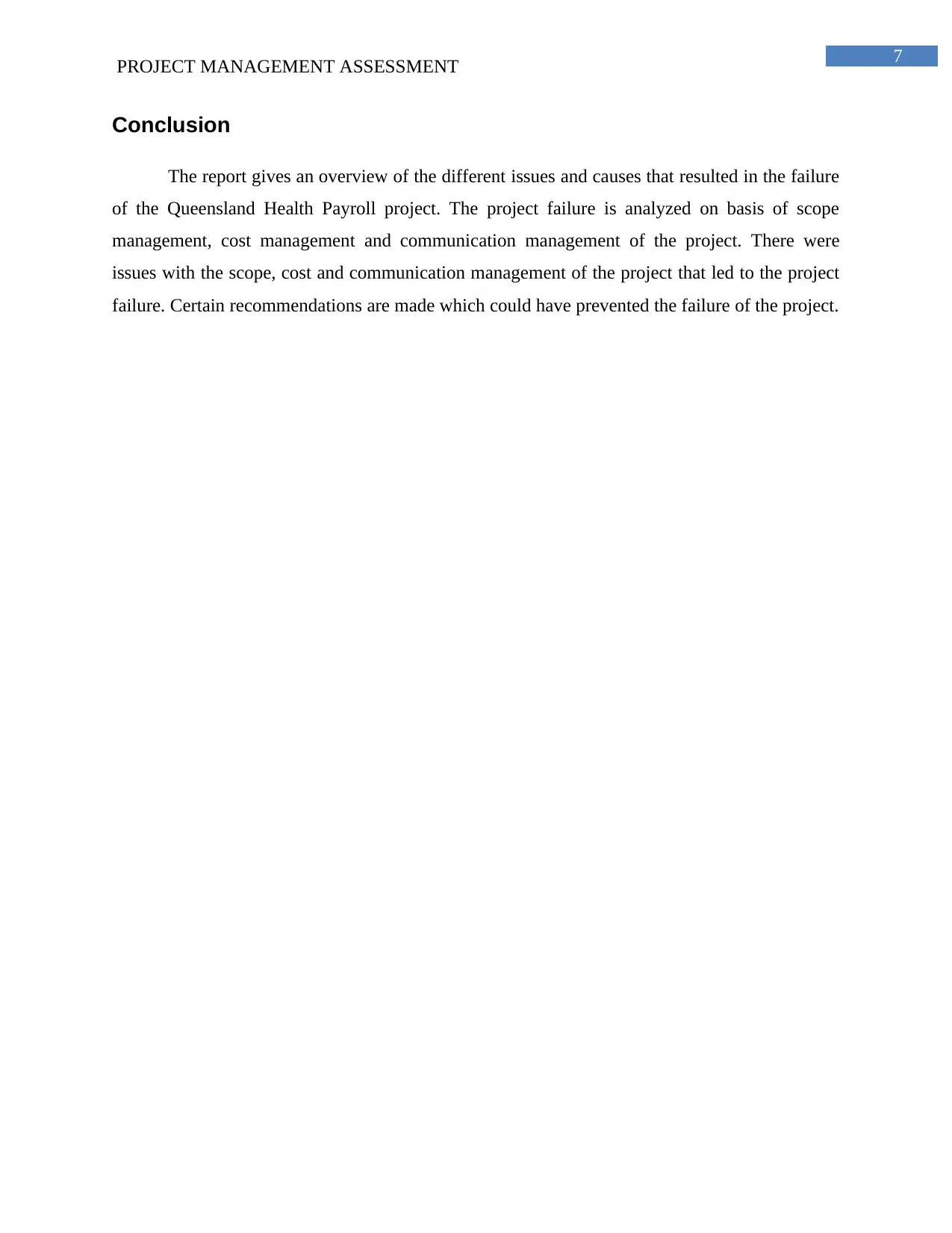
7
PROJECT MANAGEMENT ASSESSMENT
Conclusion
The report gives an overview of the different issues and causes that resulted in the failure
of the Queensland Health Payroll project. The project failure is analyzed on basis of scope
management, cost management and communication management of the project. There were
issues with the scope, cost and communication management of the project that led to the project
failure. Certain recommendations are made which could have prevented the failure of the project.
PROJECT MANAGEMENT ASSESSMENT
Conclusion
The report gives an overview of the different issues and causes that resulted in the failure
of the Queensland Health Payroll project. The project failure is analyzed on basis of scope
management, cost management and communication management of the project. There were
issues with the scope, cost and communication management of the project that led to the project
failure. Certain recommendations are made which could have prevented the failure of the project.
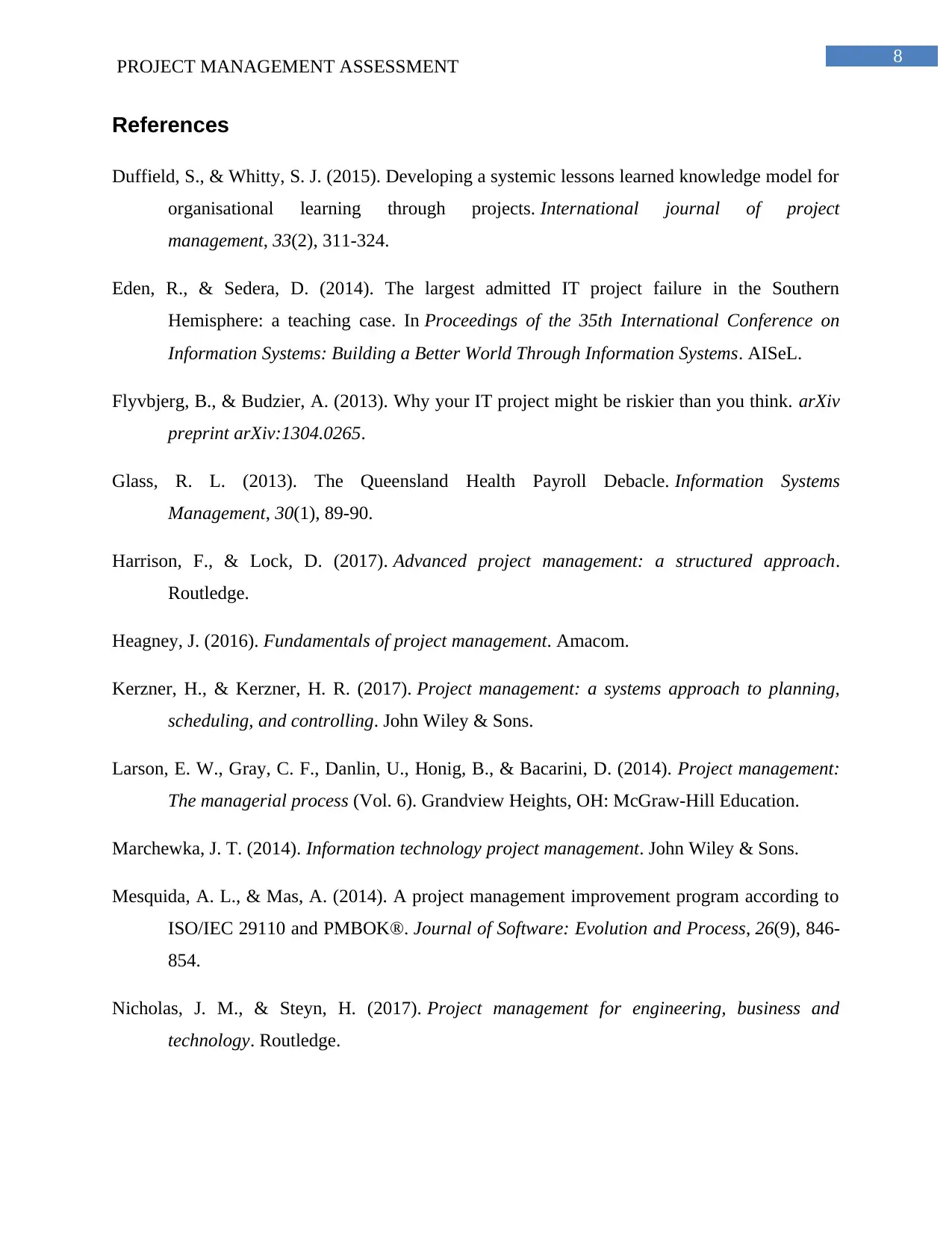
8
PROJECT MANAGEMENT ASSESSMENT
References
Duffield, S., & Whitty, S. J. (2015). Developing a systemic lessons learned knowledge model for
organisational learning through projects. International journal of project
management, 33(2), 311-324.
Eden, R., & Sedera, D. (2014). The largest admitted IT project failure in the Southern
Hemisphere: a teaching case. In Proceedings of the 35th International Conference on
Information Systems: Building a Better World Through Information Systems. AISeL.
Flyvbjerg, B., & Budzier, A. (2013). Why your IT project might be riskier than you think. arXiv
preprint arXiv:1304.0265.
Glass, R. L. (2013). The Queensland Health Payroll Debacle. Information Systems
Management, 30(1), 89-90.
Harrison, F., & Lock, D. (2017). Advanced project management: a structured approach.
Routledge.
Heagney, J. (2016). Fundamentals of project management. Amacom.
Kerzner, H., & Kerzner, H. R. (2017). Project management: a systems approach to planning,
scheduling, and controlling. John Wiley & Sons.
Larson, E. W., Gray, C. F., Danlin, U., Honig, B., & Bacarini, D. (2014). Project management:
The managerial process (Vol. 6). Grandview Heights, OH: McGraw-Hill Education.
Marchewka, J. T. (2014). Information technology project management. John Wiley & Sons.
Mesquida, A. L., & Mas, A. (2014). A project management improvement program according to
ISO/IEC 29110 and PMBOK®. Journal of Software: Evolution and Process, 26(9), 846-
854.
Nicholas, J. M., & Steyn, H. (2017). Project management for engineering, business and
technology. Routledge.
PROJECT MANAGEMENT ASSESSMENT
References
Duffield, S., & Whitty, S. J. (2015). Developing a systemic lessons learned knowledge model for
organisational learning through projects. International journal of project
management, 33(2), 311-324.
Eden, R., & Sedera, D. (2014). The largest admitted IT project failure in the Southern
Hemisphere: a teaching case. In Proceedings of the 35th International Conference on
Information Systems: Building a Better World Through Information Systems. AISeL.
Flyvbjerg, B., & Budzier, A. (2013). Why your IT project might be riskier than you think. arXiv
preprint arXiv:1304.0265.
Glass, R. L. (2013). The Queensland Health Payroll Debacle. Information Systems
Management, 30(1), 89-90.
Harrison, F., & Lock, D. (2017). Advanced project management: a structured approach.
Routledge.
Heagney, J. (2016). Fundamentals of project management. Amacom.
Kerzner, H., & Kerzner, H. R. (2017). Project management: a systems approach to planning,
scheduling, and controlling. John Wiley & Sons.
Larson, E. W., Gray, C. F., Danlin, U., Honig, B., & Bacarini, D. (2014). Project management:
The managerial process (Vol. 6). Grandview Heights, OH: McGraw-Hill Education.
Marchewka, J. T. (2014). Information technology project management. John Wiley & Sons.
Mesquida, A. L., & Mas, A. (2014). A project management improvement program according to
ISO/IEC 29110 and PMBOK®. Journal of Software: Evolution and Process, 26(9), 846-
854.
Nicholas, J. M., & Steyn, H. (2017). Project management for engineering, business and
technology. Routledge.
⊘ This is a preview!⊘
Do you want full access?
Subscribe today to unlock all pages.

Trusted by 1+ million students worldwide
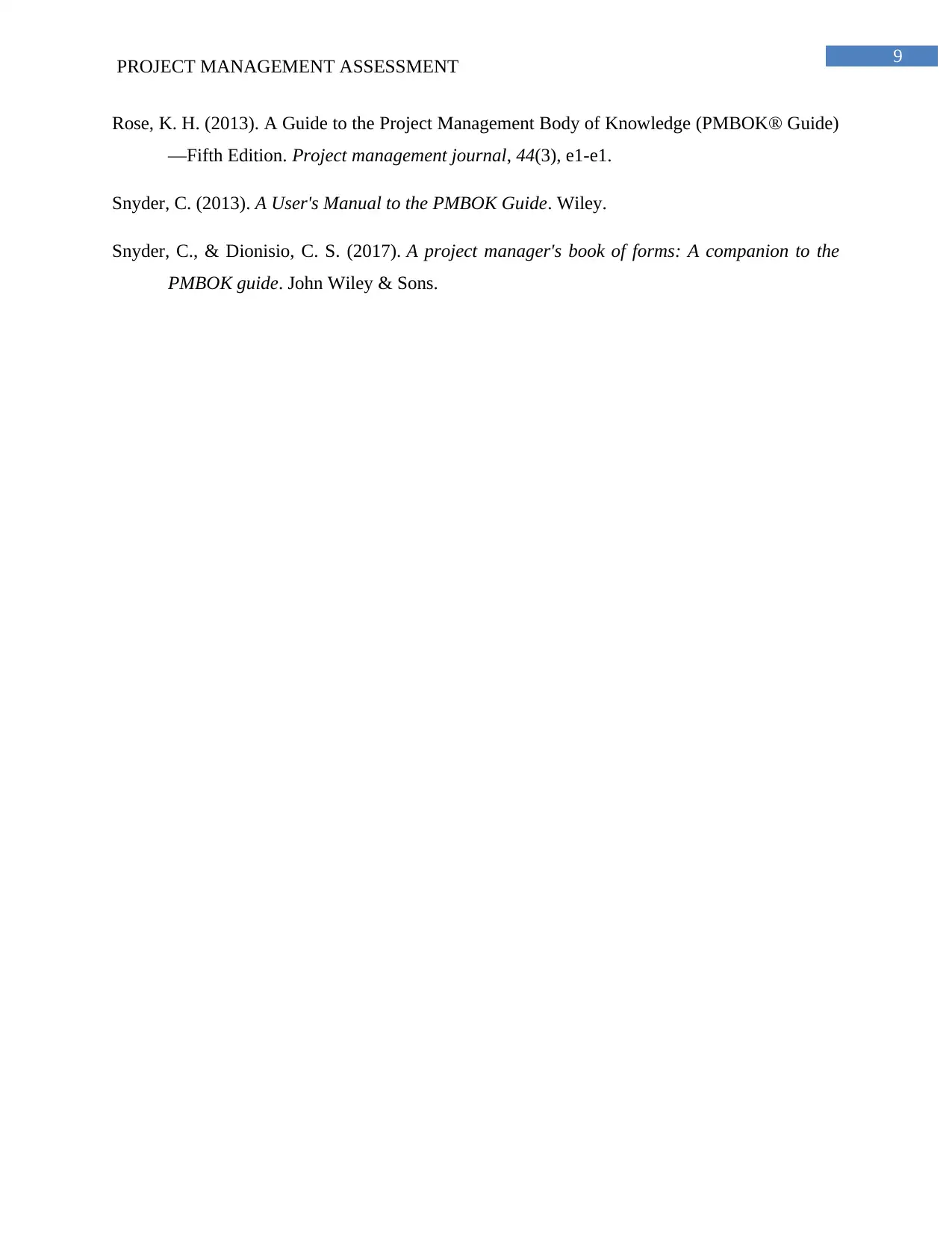
9
PROJECT MANAGEMENT ASSESSMENT
Rose, K. H. (2013). A Guide to the Project Management Body of Knowledge (PMBOK® Guide)
—Fifth Edition. Project management journal, 44(3), e1-e1.
Snyder, C. (2013). A User's Manual to the PMBOK Guide. Wiley.
Snyder, C., & Dionisio, C. S. (2017). A project manager's book of forms: A companion to the
PMBOK guide. John Wiley & Sons.
PROJECT MANAGEMENT ASSESSMENT
Rose, K. H. (2013). A Guide to the Project Management Body of Knowledge (PMBOK® Guide)
—Fifth Edition. Project management journal, 44(3), e1-e1.
Snyder, C. (2013). A User's Manual to the PMBOK Guide. Wiley.
Snyder, C., & Dionisio, C. S. (2017). A project manager's book of forms: A companion to the
PMBOK guide. John Wiley & Sons.
1 out of 10
Related Documents
Your All-in-One AI-Powered Toolkit for Academic Success.
+13062052269
info@desklib.com
Available 24*7 on WhatsApp / Email
![[object Object]](/_next/static/media/star-bottom.7253800d.svg)
Unlock your academic potential
Copyright © 2020–2025 A2Z Services. All Rights Reserved. Developed and managed by ZUCOL.





